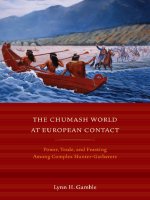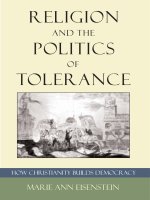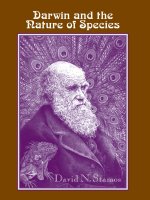university of texas press death and the classic maya kings jan 2009
Bạn đang xem bản rút gọn của tài liệu. Xem và tải ngay bản đầy đủ của tài liệu tại đây (5.28 MB, 313 trang )
T4894.indb iT4894.indb i 10/30/08 12:37:41 PM10/30/08 12:37:41 PM
e Linda Schele Series in Maya and Pre-Columbian Studies
T4894.indb iiT4894.indb ii 10/30/08 12:37:42 PM10/30/08 12:37:42 PM
.
Austin
T4894.indb iiiT4894.indb iii 10/30/08 12:37:42 PM10/30/08 12:37:42 PM
is series was made possible through the generosity of
William C. Nowlin, Jr., and Bettye H. Nowlin, the National
Endowment for the Humanities, and various individual donors.
Copyright © by the University of Texas Press
All rights reserved
Printed in the United States of America
First edition,
Requests for permission to reproduce material from this work should be sent
to:
Permissions
University of Texas Press
P.O. Box
Austin, TX -
www.utexas.edu/utpress/about/bpermission.html
e paper used in this book meets the minimum requirements of
/ .- () (Permanence of Paper).
Library of Congress Cataloging-in-Publication Data
Fitzsimmons, James L.
Death and the classic Maya kings / by James L. Fitzsimmons. — st ed.
p. cm. — ( e Linda Schele series in Maya and Pre-Columbian
Studies)
Includes bibliographical references and index.
---- (cl. : alk. paper)
. Mayas—Kings and rulers—Death and burial. . Mayas—Funeral
customs and rites. . Mayan languages—Writing. . Tombs—Mexico.
. Human remains (Archaeology)—Mexico. . Mexico—Antiquities.
I. Title.
..
.'—dc
00-T4894-FM-LH1.indd iv00-T4894-FM-LH1.indd iv 11/5/08 11:27:24 AM11/5/08 11:27:24 AM
for Rebecca
00-T4894-FM-LH1.indd v00-T4894-FM-LH1.indd v 11/5/08 11:27:24 AM11/5/08 11:27:24 AM
THIS PAGE INTENTIONALLY LEFT BLANK
xi
xv
xvii
:
Anthropology and Death Rituals
e Classic Maya Case
Methodological Concerns
Kingship and the Ancestors
:
Earth
Maize
Mortality
Writing Death
e Self and the Soul
Breaths of Life and Death
Way
To the Afterlife
Celestial Bodies and Maize Gods
:
Waiting for Interment
Gravemakers
Tombs as Underworld Surfaces
Tombs as Caves
T4894.indb viiT4894.indb vii 10/30/08 12:37:43 PM10/30/08 12:37:43 PM
viii
Tombs as Houses
Timing and the Ritual Process
Embalming and Processing
Dressing and Bundling the Corpse
Painting
Arranging the Body, Arranging the Furniture
Sealing the Tomb
:
K’inich Yax K’uk’ Mo’
Lowland Founders and Local Variations
Cults of Personality
Bird Jaguar IV
Gods and Orchards at Palenque
Souls within Buildings
Ancestor Shrines
:
Patterns of Reentry at Piedras Negras
Fire in the Motmot Burial
Fire and History at Tonina
Family Aff airs
False Reentry
Painting, Drilling, and Bone Peeling
e Portable Dead
:
Royal Funerals: Public or Private?
Bodies and Monuments
Corpses, Souls, and Mourners in Transition
:
:
T4894.indb viiiT4894.indb viii 10/30/08 12:37:43 PM10/30/08 12:37:43 PM
ix
:
T4894.indb ixT4894.indb ix 10/30/08 12:37:43 PM10/30/08 12:37:43 PM
THIS PAGE INTENTIONALLY LEFT BLANK
A section of color plates follows page 154
Fig. . The Maya area
Fig. . Piedras Negras Panel
Fig. . An Underworld scene
Fig. . The death of Wak Chan K’ahk’ and the Seven-Black-
Yellow-Place of Tonina Monument
Fig. . Chaak, God A, and the Jaguar God of the Underworld
Fig. . Hun Ajaw and Yax B’alam
Fig. . Crocodile from Copan Altar T
Fig. . Waxaklajuun Ub’aah K’awiil as the Maize God on
Copan Stela H
Fig. . Maize personified on the Temple of the Cross
Fig. . The “death” verb cham
Fig. . Section of Tikal Altar that describes a woman as deceased
Fig. . Breath escaping from nostrils as t’ab’ay
Fig. . Variants of k’a’ay u sak “flower” ik’il
Fig. . Sak, “white,” glyph as an exhaling flower on Stela ,
Yaxchilan
Fig. . Phrase k’a’ay u sak “flower”
Fig. . Mok Chi (God A’) on an unprovenanced vessel
Fig. . Ochb’ih and och haj
Fig. . Excerpt from Quirigua Zoomorph G, west
Fig. . Iconography on Tikal bones from Burial
Fig. . Iconography from Early Classic Rio Hondo vase
Fig. . Examples of och b’ih and och ha’ on Tikal Stela
Fig. . Onyx vessel from Hix Witz
Fig. . Glyph for u b’aah
Fig. . Classic Maya way killing other way
T4894.indb xiT4894.indb xi 10/30/08 12:37:43 PM10/30/08 12:37:43 PM
xii
Fig. . Lords of the Underworld as captives
Fig. . Yax Ehb’ Xook as K’inich Ajaw
Fig. . Kan B’alam as the Jaguar God of the Underworld
Fig. . Detail of Figure from the tomb of K’inich Janaab’ Pakal I
Fig. . Detail of K’inich Janaab’ Pakal I on his Sarcophagus Lid
Fig. . Detail from the Palenque Sarcophagus Lid and Yax
K’uk’ Mo’ on the Rosalila Structure at Copan
Fig. a. Maya lord with mourners
Fig. b. Maya lords being reborn as trees
Fig. . Río Azul Tomb paintings
Fig. . Tikal Burial
Fig. . Río Azul Tomb
Fig. . Two examples of bundles in Maya art
Fig. . Tikal Burial
Fig. . Piedras Negras Burial
Fig. . Socketed bloodletter from Piedras Negras Burial
and deified bloodletters from Tikal Burial
Fig. . Tikal Burial
Fig. . Tikal Burial
Fig. . Piedras Negras Burial
Fig. . Death and transformation on K
Fig. . Plan view of K’inich Janaab’ Pakal I’s tomb
Fig. . The Copan site core, showing Temples and
Fig. . The west side of the Rosalila structure
Fig. . The Tikal site core
Fig. . Tikal Burial
Fig. . Seibal Tablet VI
Fig. . Yaxchilan Stela
Fig. . The Sarcophagus Lid at Palenque
Fig. . Sides of the Palenque Sarcophagus Lid
Fig. . Lady Olnal (Figure ) from the tomb of
K’inich Janaab’ Pakal I
Fig. . The “Dazzler” vessel from Copan Burial XXXVII-
Fig. . Caracol B--nd tomb showing sealed capstones
Fig. . Yaxchilan Lintel
Fig. . Map of Yaxchilan showing Structure
Fig. . Caracol Stela excerpt
T4894.indb xiiT4894.indb xii 10/30/08 12:37:43 PM10/30/08 12:37:43 PM
xiii
x
Fig. . K’inich Yo’nal Ahk I
Fig. . Yaxchilan Lintel
Fig. . A scene of sacrifice from K
Fig. . Piedras Negras Stela , right
Fig. . The Motmot marker at Copan
Fig. . Tonina Monument
Fig. . Tikal Altar and Stela
Table . Liminality
Table . Known Deified or Celestial Ancestors
Table . Death and Burial Dates of Classic Maya Rulers
Table . “Founders” of the Classic Maya Lowlands
Table . Reentered Royal Tombs of the Classic Maya Lowlands
Table . Death and Accession Dates at Classic Maya Sites –
T4894.indb xiiiT4894.indb xiii 10/30/08 12:37:43 PM10/30/08 12:37:43 PM
THIS PAGE INTENTIONALLY LEFT BLANK
T
he hieroglyphic orthography used in this book largely conforms to that
used in Reading the Maya Glyphs by Michael Coe and Mark Van Stone.
e one exception involves words bearing the consonant b: given that all other
glottal sounds are represented in this text, and that b is universally glottal, I
have chosen to use prime to represent the sound b′ as well.
Author’s Note: Figures , , , , , , and are from the Corpus of
Maya Hieroglyphic Inscriptions and are reproduced here courtesy of the Presi-
dent and Fellows of Harvard College. e CMHI is an active research archive
and ongoing recording program of the Peabody Museum of Archaeology and
Ethnology, Harvard University, devoted to the recording and dissemination of
information about all known ancient Maya inscriptions and their associated
fi gurative art.
T4894.indb xvT4894.indb xv 10/30/08 12:37:44 PM10/30/08 12:37:44 PM
THIS PAGE INTENTIONALLY LEFT BLANK
x
D
eath and the Classic Maya Kings is a book about the ties between what is
archaeologically observed—the “death” in material culture as represented
by burials, funerary architecture, and grave furniture—and what was recorded
by the Classic Maya scribes. In the course of writing this book, an adaptation
of my Ph.D. dissertation, numerous foundations and institutions provided me
with generous fi nancial and logistical assistance during my fi eldwork at Piedras
Negras and Zapote Bobal, as well as throughout the trajectory of my graduate
and postgraduate studies.
Without fi nancial aid from the Department of Anthropology, Harvard
University; the U.S. Department of Education (Foreign Languages and Areas
Studies program); the Whiting Fellowship Foundation; the Center for World
Religions (Harvard University); the Owens Fund; the Mellon Foundation; and,
in large part, Middlebury College, this book would not have been realized. Re-
search at Piedras Negras was carried out as part of the Proyecto Piedras Negras
and generously supported by a number of the above institutions and funds. In
addition, the project received generous donations and support from the Univer-
sidad del Valle, Guatemala; Ken Woolley and Spence Kirk, of Salt Lake City;
the Foundation for the Advancement of Mesoamerican Studies, Inc. ();
the Ahau Foundation; the National Science Foundation; the Fulbright Fel-
lowship Program; Fulbright-Hayes; the Heinz Foundation; the Rust Fund of
Brigham Young University; and the Albers Trust of Yale, along with research
funds from former Dean Clayne Pope and Vice President Gary Hooper of
Brigham Young University. My fi eld and laboratory eff orts no doubt benefi ted
from these august institutions and individuals.
I thank all the members of the Proyecto Piedras Negras not only for their
support and academic assistance but also for their friendship. I wish to especially
thank the Instituto de Antropología e Historia () and project codirector
Héctor L. Escobedo, who, along with Stephen D. Houston, provided me with
the opportunity to excavate and research at the site. Likewise, David Webster,
Kitty Emery, and Lori Wright imparted crucial insights both inside and out-
side the fi eld, particularly with respect to the Piedras Negras Burial materi-
als. Personal correspondence with several other project members was likewise
T4894.indb xviiT4894.indb xvii 10/30/08 12:37:44 PM10/30/08 12:37:44 PM
xviii
ii
critical in the development of this work. Particularly the eff or
ts of Mark and
Jessica Child, Charles Golden, Zachary Hruby, Amy Kovack, A. Rene Muñoz,
and Andrew Scherer to clarify and explain the results of their excavations—as
well as my own—aff orded me avenues of inquiry that I would otherwise have
ignored. Special thanks go to Zachary Hruby and Heather Hurst, whose draw-
ings continue to serve in all things related to Piedras Negras archaeology.
I also extend my appreciation to all of the Guatemalan archaeologists who
have worked with the Proyecto Piedras Negras over the years. Excavations re-
alized by Tomás Barrientos, Carlos Alvarado, and Marcelo Zamora, working
under the auspices of Escobedo, were of specifi c import to this book. Likewise
the eff orts of Lillian Garrido and Ernesto Arredondo Leiva to provide me with
insights into the functions of structures overlooking the West Group Plaza
cannot be ignored. At the same time, I would like to extend my appreciation to
all the workers and support staff of the Proyecto Piedras Negras: without their
tireless endeavors, the project would have soon collapsed. Heartfelt thanks also
go to Srs. Joaquín Aguilar and José “Arnoldo” Ramírez. Although they may
not ever read this, these individuals are never far from my thoughts of Piedras
Negras.
In addition, I would like to thank all the members of the Proyecto Petén
Noroccidente Hix Witz (Zapote Bobal) for their continued support and insight.
In particular, Laura Gámez, Véronique Breuil, Melanie Forné, Edy Barrios,
Edwin Roman, Franz Lauer, Bryan Carlo, and Charlotte Arnauld have con-
tributed directly to the information presented in this book, either from research
at La Joyanca, Zapote Bobal, or both. eir moral and intellectual support,
together with that of the people of Vistahermosa, Guatemala, has been—and
continues to be—an inspiration.
Beyond these projects, I must acknowledge the eff orts of all the archaeolo-
gists and epigraphers referred to in this work; without their publications, cor-
respondence, and expertise, the archaeology of Classic Maya death would be
confi ned to a much smaller work. Specifi cally, the insights of Wendy Ashmore,
Harvey and Victoria Bricker, Jane Buikstra, Karla Davis-Salazar, Barbara Fash,
R. Jeff rey Frost, Ian Graham, Takeshi Inomata, Rosemary Joyce, George Lau,
Patricia McAnany, Gordon Rakita, Nora Reber, Izumi Shimada, and Karl
Taube have, over the years, contributed greatly to my ideas about the archae-
ology of the Americas, ceremony, epigraphy, and iconography. In addition to
those mentioned above, I would like to thank the many individuals and institu-
tions who generously contributed to the photographs and images in this work,
including the Corpus of Maya Hieroglyphic Inscriptions (Harvard University),
the Foundation for the Advancement of Mesoamerican Studies, Inc., the Penn
Museum (University of Pennsylvania), Arlen Chase, Diane Chase, Barbara
Fash, Grant Hall, Stephen Houston, Justin and Barbara Kerr, Merle Greene
Robertson, and David Stuart. Doubtless there are others. To these people I
extend my apologies for their omission.
T4894.indb xviiiT4894.indb xviii 10/30/08 12:37:44 PM10/30/08 12:37:44 PM
xix
is project could not have been written without the generous institutional
support of Dumbarton Oaks, Washington, D.C., and the Sainsbury Research
Unit of the University of East Anglia. e majority of my dissertation revisions
took place at these institutions; I thank them for providing me with superb
library access as well as accommodations during my years there. In particular,
I would like to thank Jeff rey Quilter, Steven Hooper, and Joanne Pillsbury not
only for their support but also for their faith in me as a scholar. I would also like
to thank Charlene Barrett and Ann Nottingham for their logistical assistance
subsequent to my time at these institutions. Moreover, I would like to extend
my gratitude to the editorial staff at the University of Texas Press.
David Stuart, William L. Fash, and Stephen D. Houston have sacrifi ced
countless hours guiding me through my academic career. Working with David
Stuart on all things hieroglyphic has been a rewarding experience: I cannot
emphasize enough his contribution to my understanding of—and enthusiasm
for—Classic Maya writing. With an ability to recall and explain almost any
inscription, David Stuart was formative in the development of this thesis. In
addition to providing me with the opportunity to work at Copan, William L.
Fash was instrumental to my academic growth at Harvard University and con-
tinues to extend a helping hand through all the numerous “crises” in graduate
and postgraduate life. Stephen D. Houston has, along with Escobedo, played an
integral role in my archaeological research at Piedras Negras (as well as in the
publication of that material). I benefi ted from Houston’s encyclopedic knowl-
edge of Classic Maya inscriptions throughout the course of writing this book. I
am particularly indebted to the above individuals for their tireless support, for
their criticisms as well as their congratulations.
My fi nal acknowledgments go to my family, who have supported me person-
ally and professionally over the course of my time at Harvard University and in
my postgraduate career. With me they have endured the frenetic life of an aca-
demic in the fi nal stages of turning a dissertation into a book, from panic and
despair to relief and (subsequent) lethargy. In addition to my parents, Kevin
and Teresa Fitzsimmons, I would like to thank Laura Fitzsimmons as well as
Clara, Molly, and Lena. Lastly, I wish to thank my wife, Rebecca Bennette,
whose tireless devotion surprises me every day of my life.
T4894.indb xixT4894.indb xix 10/30/08 12:37:44 PM10/30/08 12:37:44 PM
THIS PAGE INTENTIONALLY LEFT BLANK
T4894.indb xxiT4894.indb xxi 10/30/08 12:37:45 PM10/30/08 12:37:45 PM
THIS PAGE INTENTIONALLY LEFT BLANK
R
ituals surrounding death are informed not only by biological concerns
but also by social and religious norms of behavior. As a primary focus in
sociocultural anthropology, the study of death witnessed an explosion in theo-
retical refi nement and scope over the last few decades of the twentieth cen-
tury, expanding far beyond its modest nineteenth-century origins in the study
of social organization to address broad philosophical and anthropological is-
sues.
Archaeology has followed a similar path, with speculative, chronologi-
cal, and cultural approaches to burials supplanted by the concerns of proces-
sual and postprocessual theory.
Yet most analytical approaches to death have at
their theoretical roots the work of early-twentieth-century sociologists such as
Robert Hertz and Arnold van Gennep, themselves the by-products of a larger,
late-nineteenth-century tradition initiated by Émile Durkheim and published
in L’ Année sociologique. rough their work, we see death refl ecting and shaping
social values,
ideas that fi nd resonance even among the tombs and temples of
Classic Period Mesoamerica.
e crux of van Gennep’s thesis, originally formulated for societies in Mada-
gascar and Indonesia, is that death rituals—part of a class of rituals concerned
with the transition from one status to another, such as initiation or marriage—
consist of a tripartite structure. ese involve a separation from the original sta-
tus, a liminal period, and a reincorporation of the individual into a new social
status; a “death” and subsequent “rebirth” into a new identity are characteristic
of each of the three stages.
Hertz dealt with a similar situation in Borneo: his fi eldwork revealed a num-
ber of societies that did not see death as instantaneous. One notable example
from his research involves a period when the body is neither alive nor fully dead.
Set rituals are undertaken, including secondary burial and feasting, to bring
the dead out of the liminal stage into a new social status, that of an ancestor.
Although Hertz did not categorize or even number these stages, his concern
with the liminal phase of death rites has, along with van Gennep’s approach,
set the standard for subsequent elaborations and refi nements of the anthropol-
ogy of mortuary ritual.
More important for the present study, however, has
been his idea that the changing state of the body during these ceremonies often
T4894.indb 1T4894.indb 1 10/30/08 12:37:45 PM10/30/08 12:37:45 PM
refl ects the changing state of the soul. Viewing these states from three sides of
death—corpse, soul, and mourners—Hertz pioneered a new form of compara-
tive analysis that continues to be used in modern research.
As can be surmised, the application of these ideas—or their subsequent
elaborations—to archaeological contexts presents a diffi cult problem. Lacking
living participants in ancient death rites, archaeologists are denied direct access
to ceremony outside of ethnographic or ethnohistoric information. Attempting
to view “the three sides of death” is far more diffi cult when all of the participants
have expired! Nevertheless, traditional approaches to rank and status are today
complemented by studies addressing death in all its symbolic and sociological
roles, including cultural attitudes toward mortality as well as ideas about the
afterlife.
In Mesoamerica, works by van Gennep, Hertz, or other more recent
theorists have had a lesser impact; in the Maya lowlands, there have not been
many attempts to reconcile the anthropology of death with artifactual remains
in a systematic way.
For the Classic Maya (AD –), the works of Alberto Ruz Lhuillier and
W. Bruce M. Welsh remain the foremost analyses of burial practice. e for-
mer’s focus on grave goods, orientation, and patterns in mortuary practice was
adopted in subsequent studies of the Maya area and at Teotihuacan.
Docu-
menting the widespread presence of specifi c grave goods and burial patterns for
the Classic Maya, Ruz Lhuillier synthesized information from numerous sites
throughout the lowlands, building upon interpretations from site reports and
attempting to reconstruct elements of Classic Maya religion and ideology. e
task of reconstructing elements of Classic Maya religion has since been met in
a variety of ways, ranging from specifi c analyses of underworld supernaturals to
generalized treatments of belief systems.
e more technical study by Welsh established fi rm grave typologies for the
Maya lowlands and dealt with grave orientations, social implications of grave
goods, and general burial practices based on patterns in such behavior as skel-
etal mutilation or human sacrifi ce among elite as well as household interments.
As he did not examine epigraphic or iconographic data, Welsh proposed gen-
eral patterns of Pan-Maya and regional practice based on archaeological evi-
dence augmented by references to ethnography and ethnohistory. Despite these
limitations, his work continues to be relevant to scholars of Classic Maya mor-
tuary analysis.
Recent developments in hieroglyphic and iconographic decipherment have
changed the way Classic Maya religion is studied, to the point where such is-
sues as perceptual psychology, ancestor worship, and the sociopolitical aspects
of “tomb entering” rituals can be viewed textually in the words of ancient Maya
scribes and their kings. Elaborate rites of death, spanning from days to hun-
dreds of years, have been identifi ed for specifi c individuals and support the ex-
istence of multiple stages of death and rebirth, in some ways similar to those
T4894.indb 2T4894.indb 2 10/30/08 12:37:45 PM10/30/08 12:37:45 PM









